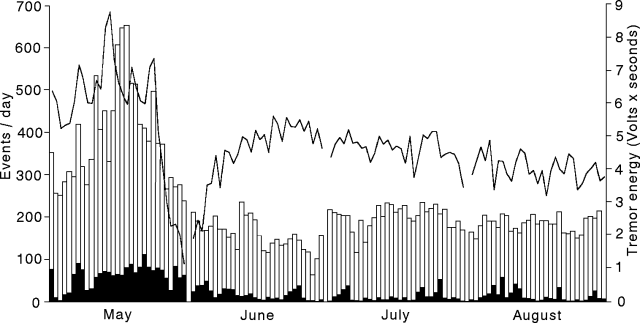Report on Stromboli (Italy) — September 1993
Bulletin of the Global Volcanism Network, vol. 18, no. 9 (September 1993)
Managing Editor: Edward Venzke.
Stromboli (Italy) Eruptive activity and seismicity decline from high levels in May; two strong explosions in October
Please cite this report as:
Global Volcanism Program, 1993. Report on Stromboli (Italy) (Venzke, E., ed.). Bulletin of the Global Volcanism Network, 18:9. Smithsonian Institution. https://doi.org/10.5479/si.GVP.BGVN199309-211040
Stromboli
Italy
38.789°N, 15.213°E; summit elev. 924 m
All times are local (unless otherwise noted)
After the eruption of a small lava flow in mid-May accompanied by high seismicity, there was an abrupt decay of seismic activity back to "normal levels" in early June (figure 31). Stromboli guides reported very low activity at the craters, with rare ejection of black ash from crater C3 and spatter from C1 during May to August. Two strong explosions felt at 0210 on 16 October destroyed the small spatter cone in C3 that was built during the October 1990 eruption. Large blocks and spatter up to 2 m in diameter were ejected as far as 500 m from the crater, and reddish ash fell on the NW slope of the volcano along the Sciara del Fuoco. One woman was injured by hot ashes while sleeping near the crater area, and some bushes caught fire along the slopes. Tremor had begun to increase around 1100 of the previous day and then fell below the detection limits of the instruments one hour after the explosions.
Geological Summary. Spectacular incandescent nighttime explosions at Stromboli have long attracted visitors to the "Lighthouse of the Mediterranean" in the NE Aeolian Islands. This volcano has lent its name to the frequent mild explosive activity that has characterized its eruptions throughout much of historical time. The small island is the emergent summit of a volcano that grew in two main eruptive cycles, the last of which formed the western portion of the island. The Neostromboli eruptive period took place between about 13,000 and 5,000 years ago. The active summit vents are located at the head of the Sciara del Fuoco, a prominent scarp that formed about 5,000 years ago due to a series of slope failures which extends to below sea level. The modern volcano has been constructed within this scarp, which funnels pyroclastic ejecta and lava flows to the NW. Essentially continuous mild Strombolian explosions, sometimes accompanied by lava flows, have been recorded for more than a millennium.
Information Contacts: M. Riuscetti, Univ di Udine.


